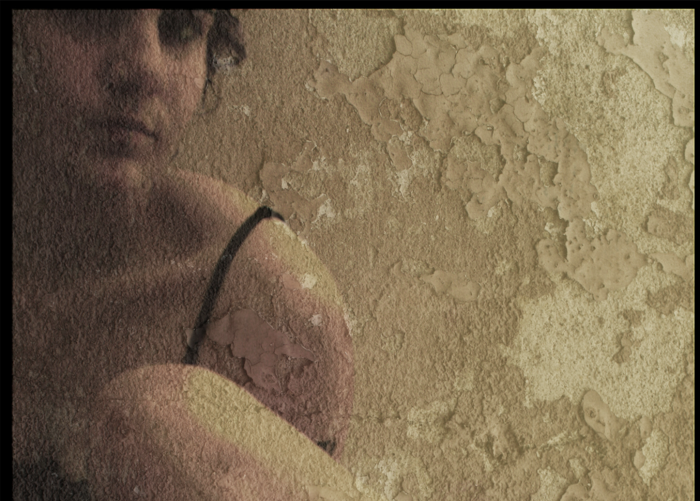*Author’s note: This is part one of a short series on this old house, and a part three fact and fiction piece.
~
Pikesville, Maryland, late summer 1988.
~
I started to peel the dark rose-colored paint in the upper left-hand corner of the east-facing room that would become my first home office. The paint was already hanging about 18 inches from that upper corner when we first toured it.
A ghastly and not welcomed sight for would-be buyers.
With the paint came a layer of wallpaper, floral I believe. It has been 34 years as I write this.
This was the first house buy for my partner of two years and I—Hank had recently turned 43, and I was 37. A bit late for some folks, perfect timing for us as we decided after two years of dating and living independently to merge our living places together in a new-to-us, 68-year-old 1920 Craftsman house.
I was transported back to my paternal grandparents’ 1919 Craftsman house in Warren, Ohio, with its large porch, and would now, here in Maryland, enter this dark wood, dimly lit house.
It was like Mumma and Pappa’s foyer and staircase to the right; it was the French doors that opened to the small living room and then larger dining room. It had the same wooden one-car garage with an attached smaller, sloped roof section for gardening tools.
This one house at some point had the upstairs converted into an apartment. Making the front large bedroom into a sunny south-facing living room, the middle bedroom remained as is. There was the original claw-foot tub, small black and white tiled floors, and a pedestal sink in the bathroom.
The back bedroom was converted into a small office and kitchen; the bedroom door had been removed, and a door leading to the office was in place. The former closet was now a pantry.
Hank claimed the second floor as his home office, using the generous sized living room and the bedroom as his, along with the bathroom. We had to gut the kitchen in order to get a loan, so we tore down the wall and created a room for my bed that I didn’t sleep in—the room became my dressing room.
I had already claimed this dingy rose walled, tacky green rug first floor bedroom with a large east-facing window as my home office. I had immediate access to the steps leading to the basement, which was a horror show that got wet every time it rained hard and steady.
I claimed it because I knew the original design of this decent-sized, sun-filled morning room would have been the kitchen. Somewhere along the line, the cold porch had been transformed into a narrow kitchen with a bathroom to the far-right side. This was another dreadful sight—cheap shower, filthy, and also, never cleaned toilet, with a decent sink, and a single light bulb dangling from the open rafters. I’ll stop there. It took a lot of stiff bristle brushing to finally scour the shower, and equal sweat to get the toilet clean.
But, back to the room—my first home office that was actually a room, not a corner of a table.
As I stripped the first layer, wondering why dark rose paint in a bedroom, I wondered who had this room when it was floral wallpaper. A woman, most likely. Was it a grandmom who was brought in to live with her daughter and son-in-law? An elderly widowed aunt? Would the parents give it to a college-age daughter to use since her siblings now numbered three? No, too soon—this was still a house with a tenant living upstairs.
A second layer of paint, pale green. Ah, still a bedroom it appears. Now another layer of wallpaper, more flowers, bright and modern. Mid twentieth century.
Next, a third layer of paint. Blue, and beneath it, why a surprise—a layer of blue bird wallpaper. Circa the 1960s perhaps, or 50s.
Now we are down to what was probably a light grey paint and perhaps still the kitchen. The dreariness of the color depicted a decade or more of meals cooked and shared in the adjacent dining room. Was the cold porch still in operation?
(Side note: the first fridge could be credited to Fred Wolf in 1913. In the late 1920s and through the 1930s more homes would add a fridge to their kitchen. At some point, large blocks of ice would no longer be delivered to homes with cold porches.)
How many families lived in this house over the decades? Real property records only go back so far. We assumed the current owner, a 30-some-year-old male middle school math teacher and coin collector had been the one to convert the upstairs into an apartment.
Hank asked the elderly gentleman next door, who was taken with watching him transform the ugly outside of the house and yard into a welcoming sight. He would stop over daily and watch Hank work and they would chat. This is per Hank since I was working at the hospital full-time. Word was that the owner prior to the clean-cut math teacher with no housekeeping nor yard skills did not do the conversion. The owner before did and rented it or provided it free, for a daughter.
Ah, that could account for the colors and wallpaper choices in the converted kitchen to first floor bedroom. Mom had control of decorating, dad worked the yard, which apparently had once been simple, yet lovely.
And now to tackle the never-vacuumed, 10-year-old, dust-mite-filled green rug.
A mask was required for this chore. I rolled the heavy rug to drag it outside and uncovered an Asian style paisley carpet made from linoleum! It was once exquisite with its shades of reds, pinks, pale and dark yellow. I debated keeping it intact, but it was cracked in areas, so I tore it apart.
And surprise—another one under it in shades of green and yellow. Yes, this would have been in place when the house was finished. Now I see that the walls were most likely a soft pale green, like sage on a winter day. Anna…I have decided the first couple to live here would have been named William and Anna.
She would stand at the sink at the large windows, watch the birds alight on the trees, and listen to their morning songs as she washed the breakfast dishes. A few years later her view would change as the vacant space would have a house built in the spot and trees would have lost their life to house another family.
Her heavy cast iron stove, coated in porcelain in a slightly darker than the walls green, sat in the room. Her kettle would sit on the back burner. The stove and cabinets would be on the north facing wall.
How many children did Anna birth? How did they fare during the Depression? I suspect she grew some vegetables and berries in the back yard, most likely in the northwest corner and near the then-small mulberry tree.
Okay back to reality, there would be work for me to do and lessons to learn in how to spackle, prime, and then paint these walls. Plus, how to get the wooden floor in decent shape.
I eventually had a home office; it took two months of some after work evenings and every weekend.
It’s time to explore another project and make new memories. But next, we visit the past and remember visits to my paternal grandparents’ house.
~
Please consider Boosting our authors’ articles in their first week to help them win Elephant’s Ecosystem so they can get paid and write more.
~












Read 42 comments and reply